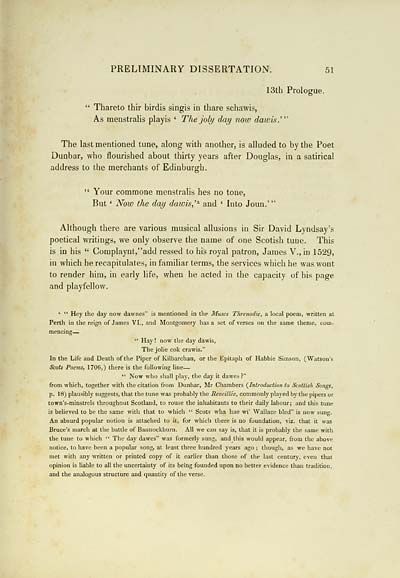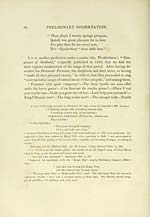Glen Collection of printed music > Printed text > Ancient Scotish melodies from a manuscript of the reign of King James VI
(73) Page 51
Download files
Complete book:
Individual page:
Thumbnail gallery: Grid view | List view

PRELIMINARY DISSERTATION. 51
13th Prologue.
" Thareto thir birdis singis in thare schawis,
As menstralis playis ' The joly day now dawis.'"'
The last mentioned tune, along with another, is alluded to by the Poet
Dunbar, who flourished about thirty years after Douglas, in a satirical
address to the merchants of Edinburgh.
" Your commone menstralis hes no tone,
But ' Now the day dawis,''^ and ' Into Joun.'"
Although there are various musical allusions in Sir David Lyndsay's
poetical writings, we only observe the name of one Scotish tune. This
is in his " Complaynt,"add ressed to his royal patron, James V.,in 1529,
in which he recapitulates, in familiar terms, the services which he was wont
to render him, in early life, when he acted in the capacity of his page
and playfellow.
^ " Hey the day now dawnes" is mentioned in the Muses Threnodie, sl local poem, written at
Perth in the reign of James VI., and Montgomery has a set of verses on the same theme, com-
mencing —
" Hay ! now the day dawis.
The jolie cok crawis."
In the Life and Death of the Piper of Kilbarchan, or the Epitaph of Habbie Simson, (Watson's
Scots Poems, 1706,) there is the following line —
" Now who shall play, the day it dawes ?"
from which, together with the citation from Dunbar, Mr Chambers (^Introduction to Scottish Songs,
p. 18) plausibly suggests, that the tune was probably the Reveillee, commonly played by the pipers or
town's-minstrels throughout Scotland, to rouse the inhabitants to their daily labour; and this tune
is believed to be the same with that to which " Scots wha hae wi' Wallace bled" is now sung.
An absurd popular notion is attached to it, for which there is no foundation, viz. that it was
Bruce's march at the battle of Bannockburn. All we can say is, that it is probably the same with
the tune to which " The day dawes" was formerly sung, and this would appear, from the above
notice, to have been a popular song, at least three hundred years ago ; though, as we have not
met with any written or printed copy of it earlier than those of the last century, even that
opinion is liable to all the uncertainty of its being founded upon no better evidence than tradition,
and the analogous structure and quantity of the verse.
13th Prologue.
" Thareto thir birdis singis in thare schawis,
As menstralis playis ' The joly day now dawis.'"'
The last mentioned tune, along with another, is alluded to by the Poet
Dunbar, who flourished about thirty years after Douglas, in a satirical
address to the merchants of Edinburgh.
" Your commone menstralis hes no tone,
But ' Now the day dawis,''^ and ' Into Joun.'"
Although there are various musical allusions in Sir David Lyndsay's
poetical writings, we only observe the name of one Scotish tune. This
is in his " Complaynt,"add ressed to his royal patron, James V.,in 1529,
in which he recapitulates, in familiar terms, the services which he was wont
to render him, in early life, when he acted in the capacity of his page
and playfellow.
^ " Hey the day now dawnes" is mentioned in the Muses Threnodie, sl local poem, written at
Perth in the reign of James VI., and Montgomery has a set of verses on the same theme, com-
mencing —
" Hay ! now the day dawis.
The jolie cok crawis."
In the Life and Death of the Piper of Kilbarchan, or the Epitaph of Habbie Simson, (Watson's
Scots Poems, 1706,) there is the following line —
" Now who shall play, the day it dawes ?"
from which, together with the citation from Dunbar, Mr Chambers (^Introduction to Scottish Songs,
p. 18) plausibly suggests, that the tune was probably the Reveillee, commonly played by the pipers or
town's-minstrels throughout Scotland, to rouse the inhabitants to their daily labour; and this tune
is believed to be the same with that to which " Scots wha hae wi' Wallace bled" is now sung.
An absurd popular notion is attached to it, for which there is no foundation, viz. that it was
Bruce's march at the battle of Bannockburn. All we can say is, that it is probably the same with
the tune to which " The day dawes" was formerly sung, and this would appear, from the above
notice, to have been a popular song, at least three hundred years ago ; though, as we have not
met with any written or printed copy of it earlier than those of the last century, even that
opinion is liable to all the uncertainty of its being founded upon no better evidence than tradition,
and the analogous structure and quantity of the verse.
Set display mode to: Large image | Transcription
Images and transcriptions on this page, including medium image downloads, may be used under the Creative Commons Attribution 4.0 International Licence unless otherwise stated. ![]()
| Special collections of printed music > Glen Collection of printed music > Printed text > Ancient Scotish melodies from a manuscript of the reign of King James VI > (73) Page 51 |
|---|
| Permanent URL | https://digital.nls.uk/91356284 |
|---|
| Description | Scottish songs and music of the 18th and early 19th centuries, including music for the Highland bagpipe. These are selected items from the collection of John Glen (1833 to 1904). Also includes a few manuscripts, some treatises, and other books on the subject. |
|---|
| Description | The Glen Collection and the Inglis Collection represent mainly 18th and 19th century Scottish music, including Scottish songs. The collections of Berlioz and Verdi collected by bibliographer Cecil Hopkinson contain contemporary and later editions of the works of the two composers Berlioz and Verdi. |
|---|

